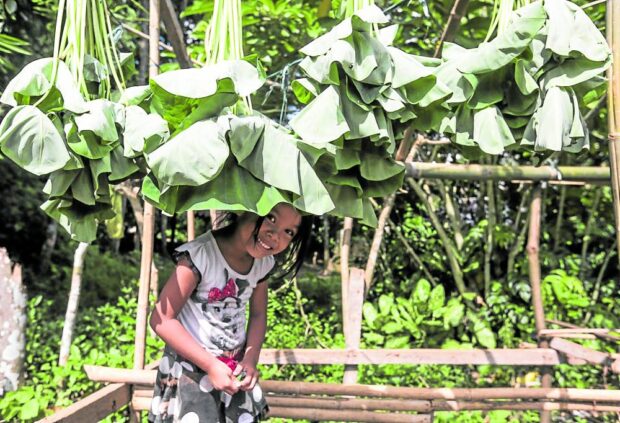Over 5K evacuees on way home as threat of Mayon blast eases

FOOD SUPPLY Gabi (taro) leaves are sun dried at an evacuation center in Barangay San Andres in Sto. Domingo, Albay, in this photo taken in July. Residents fleeing from the unrest of Mayon Volcano harvest gabi, the main ingredient in the local dish “laing” or “pinangat,” to augment their food supply while they are in temporary shelters. —MARK ALVIC ESPLANA
LEGAZPI CITY—More than 5,000 people, who took shelter in makeshift huts in Sto. Domingo, Albay, after they were forced to leave their communities in June due to Mayon Volcano’s unrest, would be sent home on Friday now that the possibility of an explosive eruption had been assessed to be “very low.”
But Sto. Domingo Mayor Joseling Aguas Jr. said 1,588 families in the villages of Lidong, Fidel Surtida, Sta. Misericordia and San Fernando, were still advised to refrain from entering the 6-kilometer radius permanent danger zone due to the threats of ashfall, lava flow and pyroclastic density currents (PDCs or ash and debris flow) along the slopes of the volcano.
“Still, residents are advised to always be prepared in case the situation worsens,” Aguas said in an advisory.
These residents, who are living inside the 7-km danger zone of the volcano, built huts made of bamboo, nipa leaves and light materials since they were evacuated on June 12 to the villages of Salvacion and San Andres.
Lahar
Edgar Balidoy, head of Sto. Domingo municipal disaster risk reduction and management office, said the families would be given relief goods before they return home while the 80 farmers who were tilling farmlands inside the permanent danger zones of the volcano would still be given livelihood assistance by the Department of Agriculture.
Article continues after this advertisement“The village officials will monitor the residents, especially the farmers, to make sure that no one will enter the danger zones,” Balidoy said in a phone interview on Thursday.
Article continues after this advertisementMore than 300 families were also sent home in the last week of August in the villages of Tandarora and Muladbucad Grande, while at least 533 families from Barangay Maninila would remain in evacuation centers due to threat of lahar flow.
After the decampment in the two towns, only 3,922 families, or 13,872 people, will be left in evacuation centers from 19 villages, records from the Albay Public Safety and Emergency Management Office (Apsemo) showed.
Cedric Daep, Apsemo chief, said families living inside the 6-km permanent danger zone would stay in shelters until the Philippine Institute of Volcanology and Seismology (Phivolcs) downgrades the current alert level 3 on Mayon.
“We will decamp the [residents living inside] the 6-km danger zone once it is lowered to alert level 2,” Daep said in a text message on Thursday.
Most of families in the cities of Tabaco and Ligao, and the towns of Sto. Domingo, Guinobatan, Camalig, Malilipot and Daraga were evacuated on June 9, a day after Phivolcs raised Mayon’s alert level to 3, meaning there was an “increased tendency toward a hazardous eruption.”
Paul Karson Alanis, resident volcanologist of Phivolcs in Legazpi City, said the effusive eruption was still ongoing, where lava flow is observed, but the chance of an explosive eruption would be “very low” based on the parameters monitored since last month.